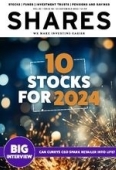Archived article
Please note that tax, investment, pension and ISA rules can change and the information and any views contained in this article may now be inaccurate.
The FTSE 100 hits 40: can it shake off a mid-life crisis?

On 3 January 2024, the FTSE 100 celebrates its 40th anniversary. And to borrow a cliche - it seems an opportune moment to ask, will life for the index truly begin at 40 or will it be plunged into a mid-life crisis?
The index was launched as a replacement for the FT-30, which as its name suggests was a grouping of 30 businesses drawn principally from the industrial and commercial sectors. The FT-30 was price-weighted, but the FTSE 100 was and continues to be weighted by market value with its list of constituents reshuffled on a quarterly basis.
Before considering its immediate future, it’s worth examining how the UK’s flagship stock index has changed since its inception as well as how its historic returns compare over term against global counterparts and inflation.
A HISTORY LESSON
From a starting point of 1000, the index has advanced to 7,666 at the time of writing - a capital return of 666% or a compound annual return of 5.2%, excluding dividends. This compares with a compound annual growth rate of less than 4% for the retail price index over the same period.
Less positively, the index has struggled to keep pace with most global counterparts, apart from Japan’s Nikkei 225. The latter market has only recently revived after a long period of Japanese economic and market stagnation.
Even more concerningly, the FTSE 100 has made very little progress since peaking at 6,930 at the height of the dotcom boom on 31 December 1999 (and ahead of its imminent bust). Somewhat ironically, it’s the lack of weighting towards the technology sector which has put it at a disadvantage to the US market in particular ever since. Through the course of the last decade, the impact of the Brexit vote and a subsequent outflow of foreign capital has kept a firm lid on the returns from the index.
Twenty-six of the FTSE 100’s founder members are still there today. Fourteen of those even have the same name, although Whitbread (WTB) is a very different animal than it was then. The other 12 original members are also ever-presents. There may have been some name changes and shifts in structure thanks to deal-making or strategy rejigs, but they would be broadly recognisable if someone from 1984 were suddenly transported to the early 2020s. A further 14 names were acquired by current FTSE 100 constituents and five are still quoted on the London Stock Exchange but have slipped down the market cap ranks and are now part of a subordinate index.
PROTECTIONS PAY OFF
It is at least some testament to the protections afforded investors in UK Main Market companies - in areas like corporate governance and transparency - that just three names from the 100 which made up the index at the outset have since gone bust.
This includes financial services and transportation firm British and Commonwealth Shipping and electrical engineering outfit Ferranti, which fell victim to poorly-executed acquisitions and, in the latter case, allegations of fraud.
The third casualty, DIY retailer MFI, was subject to a management buyout and left the market in the late 1980s before becoming a victim of the 2007/8 financial crisis as a privately-owned business.
Some would claim the index has failed to move with the times as it continues to be dominated by so-called ‘old world’ economy businesses in sectors like resources and the financial industry.
Arguably, the loss of high-profile names like BHP (BHP), which shifted its primary listing to Australia, and CRH (CRH) and Ferguson (FERG) which opted to shift their main quote to the US, together with the decision by chip designer and former UK market darling ARM (ARM:NASDAQ) to list in New York in September 2023, have also dealt a blow to London’s prestige.
In 2000, UK-listed stocks accounted for 11% of the MSCI World index - as of 30 November 2023, the proportion is less than 4%.
To offer some perspective, this is still more than the likes of France and Germany and behind only Japan if you exclude the US (which now dominates with a record 70% share).
WHAT DOES THE FUTURE LOOK LIKE?
If the FTSE 100 isn’t to drop further down the global rankings it has to be hoped planned changes to the listing rules can inject some fresh life into London as a listing venue.
However, what has to be avoided at all costs is an unthinking rush to attract as many companies as possible by compromising on listing requirements like the provision of a detailed financial track record and decent liquidity for shareholders. That would be the equivalent of a 40-year-old accountant going out and buying a motorbike and leathers.
Boosting the number of listed companies at the expense of quality and investor protection would do nothing whatsoever for the UK market’s credibility and would surely be counterproductive in the long run.
Important information:
These articles are provided by Shares magazine which is published by AJ Bell Media, a part of AJ Bell. Shares is not written by AJ Bell.
Shares is provided for your general information and use and is not a personal recommendation to invest. It is not intended to be relied upon by you in making or not making any investment decisions. The investments referred to in these articles will not be suitable for all investors. If in doubt please seek appropriate independent financial advice.
Investors acting on the information in these articles do so at their own risk and AJ Bell Media and its staff do not accept liability for losses suffered by investors as a result of their investment decisions.
Issue contents
Case study
Feature
- Return from our 2023 share picks is more than four times that of the UK market
- The best and worst emerging markets in 2023
- Can electricals leader Currys deliver some turnaround spark?
- Discover the stocks the professionals changed their minds on in 2023
- Emerging markets: China property fixes and dollar weakness
Great Ideas
- 10 stocks for 2024: our best ideas for the year ahead
- Stock pick for 2024: Adobe is one of the best ways to play AI
- Stock pick for 2024: Buy Smith & Nephew for continued recovery and re-rating potential
- Stock pick for 2024: Buy Puretech Health for lower risk access to an exciting drug portfolio
- Stock pick for 2024: MongoDB is one of the hottest software plays on AI
- Stock pick for 2024: B&M's growth ambitions and value focus make it a compelling story
- Stock pick for 2024: Hunting is attractively priced and evidence of transformation is a clear catalyst
- Stock pick for 2024: The market has not spotted RELX for the AI winner it is
- Stock pick for 2024: Just Group is so cheap and has big growth drivers behind it
- Stock pick for 2024: Hollywood Bowl is a strikingly resilient operator trading at the wrong price
- Stock pick for 2024: Take advantage of this 'generational opportunity' to buy Conduit
Investment Trusts
News
- How TSMC could set the New Year tone for tech
- Markets higher despite mixed rates messaging and what to expect from retailers
- Discover the most unloved and most-shorted UK stocks
- Costco climbs to all-time high as members clamour for cheap essentials
- A big acquisition and a slowdown in its largest market have unnerved investors in Rentokil
- UK housebuilders Taylor Wimpey and Persimmon have moved-up strongly

 magazine
magazine








